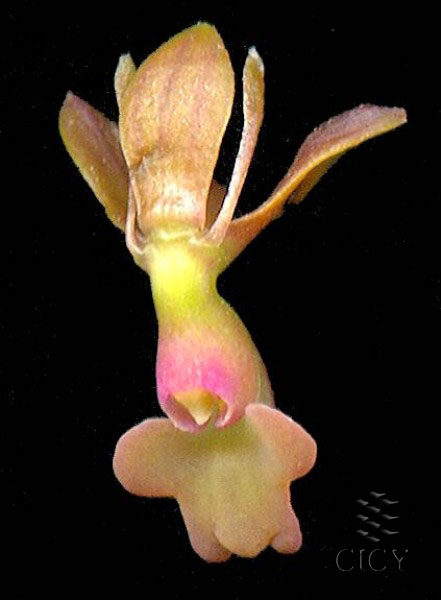

Epidendrum galeottianum A. Rich. & Galeotii 1845 GROUP Anceps SUBGROUP Anceps
Photos by © German Carnevali
Photo by © Asociación Guatemalteca de Orquideología
Drawing by © Jimenez, Hágsater & E.Santiago and The AMO Herbario Website
Nocturnal/bananas






Common Name or Meaning Galeotti's Epidendrum [Belgian Botanist in southern Mexico 1800's]
Flower Size 1/2" [1.25 cm]
Found in Mexico, Guatemala, Belize, El Salvador, Honduras and Nicaragua in high tropical forests and cloud forests at elevations of 70 to 2100 meters as a small sized, hot to cool growing epiphyte with simple, cane-like, ancipitose, straight stems carrying 4 to 10, distichous, throughout the stem, deep green to purple, coriaceous, evident dorsal keel, narrowly elliptic to oblong-lanceolate, obtuse to retuse, mucronate apically, conduplicate below into the clasping base leaves that blooms in the spring through fall on a terminal, racemose, elongate, ancipitous, 12" [30 cm] long, subcorymbose, 7 to 15 flowered inflorescence enveloped by 3 to 10 imbricating, tubular bracts and shorter than the ovary, triangular-ovate, acuminate floral bracts and producing new racemes over several years from the nodes of the peduncle, thus pluriracemose, and carries simultaneously opening, resupinate flowers that have a nocturnal scent of bananas
Often cited as a synonym of E anceps but differs in taller plants with longer purple leaves, sepals and petals are greenish brown, apex of the column and lip are purple.
"Epidendrum galeottianum, belongs to the GROUP Anceps , which is recognized by the simple stems, generally elongate, compound racemose inflorescence producing new successive racemes with time, fleshy flowers, filiform to narrowly oblanceolate petals; and the SUBGROUP Anceps which has short and sub-corymbose racemes. The species is recognized by the relatively large plants, often with purple leaves, the elongate inflorescence to 26" [65 cm] tall, the sepals and petals greenish brown and the lip and apex of the column bright, mat, purple, it is the most common species in northern mesoamerica, from Nicaragua north. It is similar to Epidendrum anceps Jacq. which has green plants and flowers and found in Costa Rica and Panama, as well as the Antillies. Epidendrum musciferum Lindl. widespread in South America and also found in Panama has smaller plants and especially flowers which are generally ochre-yellow with the column green. The flowers in this subgroup are so similar as to be difficult to describe their differences.
Synonyms Cattleya galeottiana (A.Rich. & Galeotti) Beer 1854; Epidendrum ensatum Rich & Gal. 1845; Epidendrum schenckianum Krzl. 1909
References W3 Tropicos, Kew Monocot list , IPNI ; Field Guide to the Orchids of Costa Rica and Panama Dressler 1993; Icones Orchidacearum Peruviarum Plate 469 Bennett & Christenson 1998 see comments; Harvard Pap. Bot. 5 #2: Carnevali etal. 2001; Native Ecuadorian Orchids Vol 2 Dodson 2001; Icones Orchidacearum 4 Plate 437 Hagsater 2001 see recognition section; Icones Orchidacearum 5-6 Plate 577 Hagsater 2002 see recognition section; Orchids of Mexico Hagsater, Soto, Salazar, Jimenez, Lopez and Dressler 2005; Icones Orchidacearum Vol 11 Plate 1101 Hagsater & Sanchez 2008 see recognition; Icones Orchidacearum 11 Plate 1147 Hagsater 2008 see recognition section; Icones Orchidacearum 13 Plate 1335 Hagsater 2010 drawing fide; Guia de Orquideas de Chiapas Carlos Rommel Beutelspacher Baigts 2013 photo fide; Algunas Orquideas de Mexico Tomo 1 Suarez 2013 photo fide; Orchid Genera and Species in Guatemala Archila, Szlachchetko, Chiron, Lipinska, Mystkowska and Bertolini 2018
--------------------------------------------------------------------------------------------------------------------------